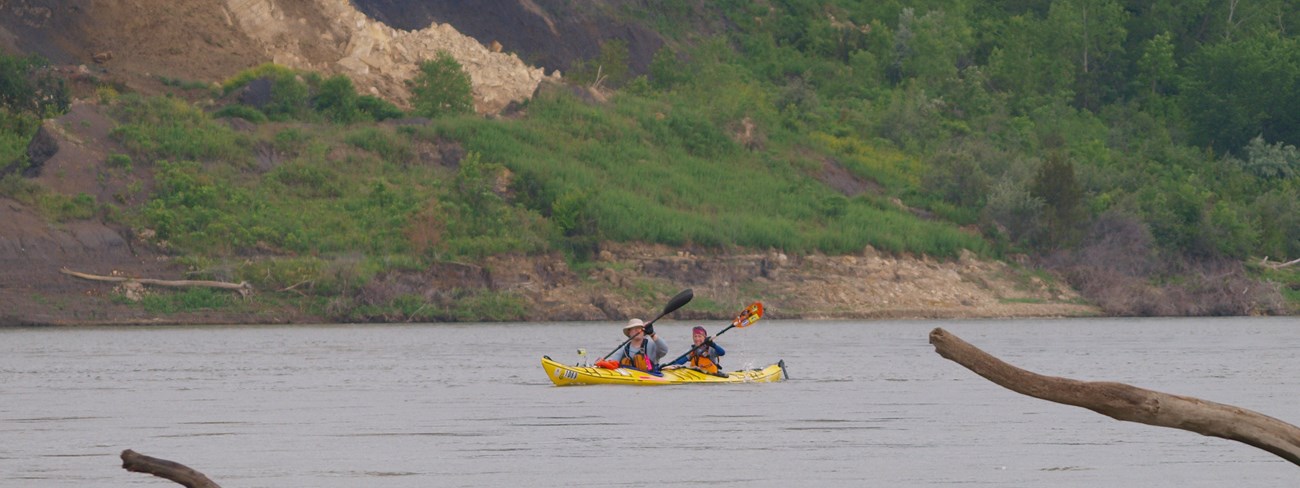
Photo by Dawne Olson Exploring the river by canoe or kayak is a great way to see the park and what Lewis and Clark may have experienced during their 1804 and 1806 travels. Appropriate watercraft is required for safely enjoying the river. Before You GoThe Missouri is a big and demanding river. Keep in mind:
Paddler's and Boaters Resources
River AccessAccess to the river is available only at public launch sites. These are few and unevenly spaced along both reaches of the park. Visit the Missouri National Recreational River Water Trail and the Missouri River Outdoor Recreation Access Guide for information. River ConditionsDepending on releases from Fort Randall Dam and Gavins Point Dam, the river can flow from 3 to 5 miles per hour. Visit the Useful Links window on the U.S. Army of Corps of Engineer's websites Gavins Point and Fort Randall for current flow rates. Use caution as local storms can temporarily increase flows as runoff pours in via the James River, Vermillion River, Bow Creek, and lesser streams. WindThe wind is an issue on most days. The wider portions of the river are most affected by wind. In the summer the prevailing wind is from the south and southwest. That, and the river current (from 3 to 5 mph), can make steering a straight course difficult. Wind can hide changes in the river by creating surface ripples, which have nothing to do with water depth. If the wind is gusty, read the surface between gusts. Wind is always a challenge with which canoeists must deal. Strong wind is something most canoeists should stay away from altogether. WeatherOn the Great Plains, storms may crop up abruptly. These storms are often accompanied by strong winds that can easily capsize a small craft. Lightning, heavy rain or hail can turn a pleasant trip into disaster. Watch the sky and be aware of your surroundings for signs of inclement weather. If you see bad weather approaching, get off the water and take cover (not under trees) as quickly as possible. Read a narrative about a two-day paddle trip from St. Helena to Ponca State Park. It provides a good example of conditions on the 59-mile stretch. CampingMost of the land along the park is privately owned and there are few public camping possibilities. Primitive camping is normally allowed on islands and sandbars, however, please adhere to restriction signs for nesting least terns and piping plovers. The river bank on both sides of the river, sandbars and islands on the Nebraska side, and deeded islands on the South Dakota side of the river are private property. Only the water belongs to the public. In areas other than designated campsites, permission is required to walk, picnic or camp on private property. Sandbars on the South Dakota side of the river are public property. In several locations along the river, the state border is still undetermined. Please adhere to the "Pack-it-in, Pack-it-out" (Leave No Trace) ethic. Call 605-665-0209 or e-mail for additional information. Protect the River & Endangered SpeciesSandbanks and bars provide habitat for the summer nesting of least terns and piping plovers. They are protected under the federal Endangered Species Act due to their low populations and loss of habitat. The chicks and eggs are difficult to see and avoid; therefore, restriction signs may be posted on sandbars to minimize disturbance to nesting colonies. Please do not disturb any nests of birds. Zebra Mussels - Aquatic Invasive SpeciesCurrently found below Gavins Point Dam in the Missouri River, Lewis and Clark Lake, as well the Mississippi River, these small, sharp-edged striped mollusks compete with native species for resources, can clog river intake structures, and create other unwanted problems. In many places, explosive population growth has led to heavy encrustation of boats, docks and native mussel species. Unfortunately, these unwanted invasive species are rapidly spreading throughout North America. For your safety it is recommended to wear swim socks or water shoes to avoid getting cut feet. Please take the time to clean your equipment and boat properly prior to launching on the Missouri or its tributaries. Personal SafetyThe National Park Service recommends wearing a life jacket at all times while in and on the water. Paddling alone is not recommended. If you go alone, let someone know your launch and take-out points as well as your estimated arrival time.
|
Last updated: September 23, 2024
